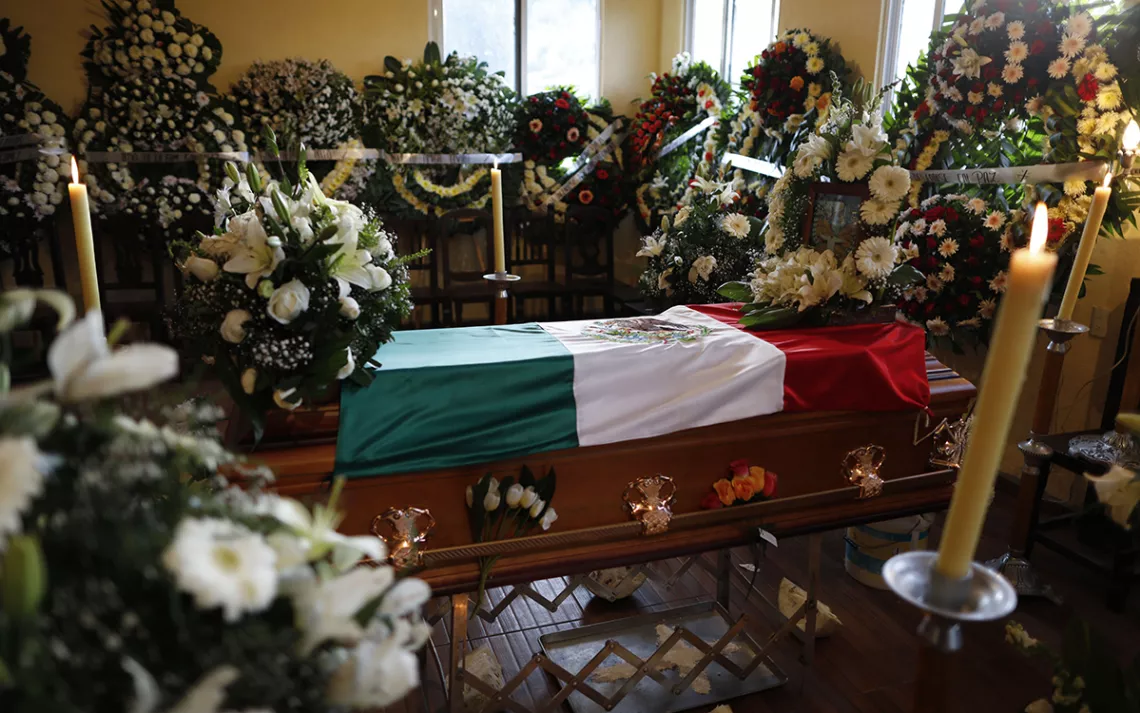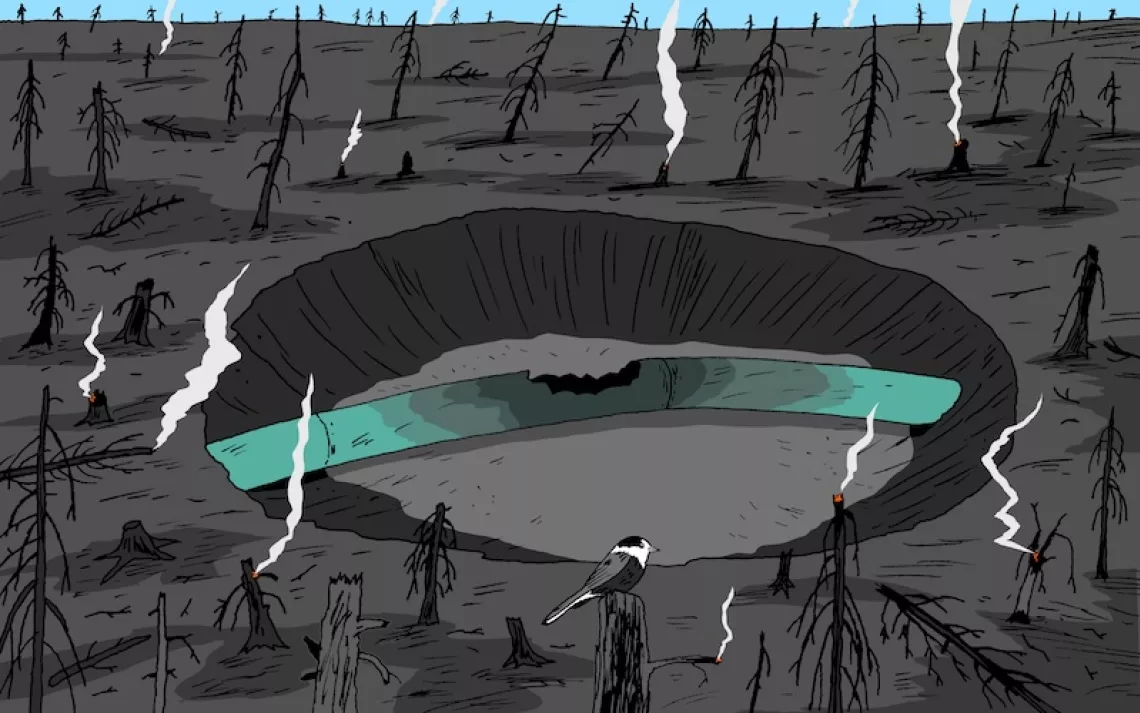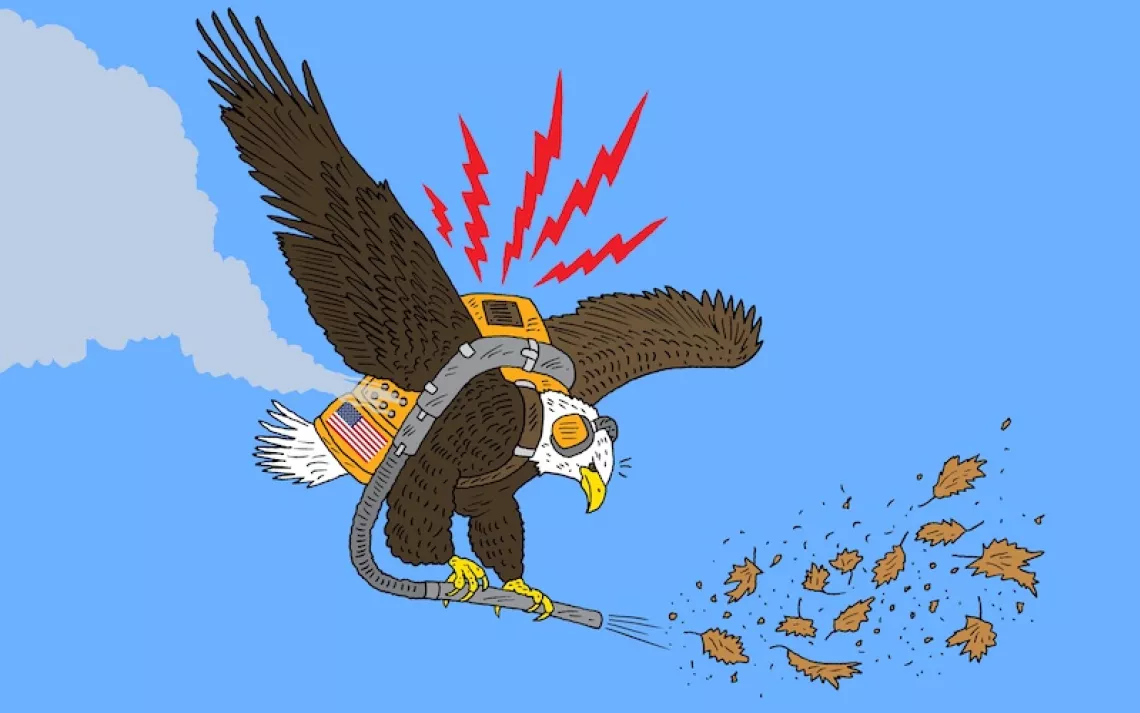Scenes From a Crime
Murders of monarch butterfly defenders in Mexico highlight ongoing impunity

The coffin of environmental activist Homero Gómez González in Ocampo, Mexico, on January 30, 2020. | Photo by AP Photo/Rebecca Blackwell
Throughout December and early January, Homero Gómez González, a 50-year-old agricultural engineer and former logger turned forest defender and butterfly enthusiast, took to Twitter to post videos of the millions of monarch butterflies recently returned to Michoacán, Mexico, for the winter.
The cellphone videos showed tall trunks of pine and fir trees carpeted in monarch wings, idyllic paths with thousands of butterflies fluttering about in search of water, and González himself standing amid the gentle chaos of myriad orange, yellow, and black wings. In one video, he invited people to come to the El Rosario Sanctuary to witness this “wonder of nature.” In another video taken at the sanctuary—part of the Monarch Butterfly Biosphere Reserve—and posted on January 12, González called the winged insects, “the lovers of the sun, the soul of the dead.”
González made his last post—a photograph of the sanctuary’s uniformed tour guides posing beneath a painted brick welcome arch—on January 13, the day he was disappeared. After losing touch with him, his family immediately reported his disappearance to the municipal police in Zitacuaro. After three days without news, they went to the Michoacán state police and organized search committees that eventually expanded to some 200 people.
In the days that followed, González’s family received calls from extortionists and paid money to what the Michoacán governor, Silvano Aureoles, called “fake kidnappers” when it became clear that the ransom calls had been made from inside a prison. The search parties worked for two weeks before they found González’s body on January 29, in a 20-foot-deep irrigation pond. He had a wound to the head and 10,000 pesos (about $500) in his pockets.
After the body was discovered, González’s brother, Amado Gómez, told reporters, “My brother was murdered. He did not fall and hit his head; this was not an accident. He was brutally beaten before he was thrown into the pond, and that beating is what killed him.”
Two days before González’s body was found, Raúl Hernández Romero, 44, a tour guide at the El Rosario Sanctuary, was also disappeared. Last seen on January 27, Romero’s family reported his disappearance on January 31, and his body was found the next day on top of a hill in El Campanario Butterfly Sanctuary, also part of the biosphere reserve in Ocampo municipality. Authorities said Romero’s body showed signs of having been beaten, including a fatal blow to the head with a sharp object. His family told the BBC that he had received threats for defending the forests.
Although shocking and horrific, the recent murders of the two Mexican environmentalists are not uncommon. They are part of a larger pattern of political violence in Mexico in which defenders of the environment often become casualties.
During the past 13 years, Mexico has become one of the world’s most dangerous countries for environmental defenders. According to a report by the Mexican Environmental Law Center, 21 environmental activists were murdered in 2018. A separate report by the “All Rights for All” Mexican human rights organization found that another 21 activists were murdered in 2019, with land and territory defenders receiving the largest number of attacks. Both reports highlight the collusion between businesses and government agencies in both carrying out the violence and ensuring impunity for the perpetrators. In 2017, the Indigenous forest defender and Goldman-award winner Isidro Baldenegro was shot down in the doorway of his aunt’s house in the sierra of Chihuahua.
As famed Mexican poet and environmental activist Homero Aridjis wrote in The New York Times on January 31, the day before Romero’s body was found, “The dilemma is simple: If Mexico keeps harassing, disappearing, and murdering activists with absolute impunity, then who will protect nature?”
The violence is not limited to activists and Indigenous leaders. Official government data showed that more than 250,000 people were murdered in Mexico between January 2006 and April 2018 in the context of the so-called drug war. Recently updated federal databases showed that more than 61,000 people had been forcibly disappeared since 2006 (although these numbers do not include the Central American migrants disappeared in Mexico on their way to the United States). Federal data also shows that only 5 percent of murders lead to a prison sentence for the perpetrator.
After the “drug war” administrations of Felipe Calderón and, later, Enrique Peña Nieto, Andrés Manuel López Obrador of the National Regeneration Movement won a landslide presidential victory in 2018 in part due to his promises to end the violence. López Obrador, commonly referred to as AMLO, made sweeping proclamations in both his campaign and his first weeks in office, promising nothing less than the “fourth transformation” of the nation. During one of the presidential debates, he famously summed up his proposed security policy as “hugs not bullets” (the Spanish phrase, “abrazos no balazos,” was promptly mocked in a viral remixed YouTube song). After coming to office, AMLO announced “the end of the neoliberal era.”
And yet, López Obrador’s first year in office has ushered in an era of neither embraces nor abolishment of neoliberal policies. In fact, 2019 was the single most violent year in recent Mexican history, with nearly 35,000 murders. Of the 21 environmentalists murdered during AMLO’s initial year in office, the first was that of a high-profile activist opposing one of the new president’s celebrated infrastructure projects. Samir Flores, an activist and community radio journalist, was shot twice in the head in his home early on February 20, 2019, just three days before the referendum on a gas pipeline and two hydroelectric plants in Morelos state. Flores organized the opposition to those projects, which López Obrador supported. Thousands of people marched to protest Flores’s murder. Nearly a year later, no one has been arrested for the crime, and Flores’s family has called on Obrador to establish a federal commission to investigate.
Environmental and human rights activists say that the current administration appears either disinterested in—or antagonistic toward—environmental protection.
López Obrador only rarely mentions the environment. The Spanish newspaper El País has showed that the new president had only mentioned the word environment ("medio ambiente") 35 times during more than 72 hours of televised news conferences during his first 100 days in office. And when administration officials do mention the environment, they often raise eyebrows. Rogelio Jiménez Pons, the tourism secretary, defended the proposed 1,500-kilometer “Maya Train” across the Yucatan Peninsula, saying, “We won’t gain anything as a country from having fat jaguars and starving children.”
Alejandra Rabasa, an environmental lawyer and member of Ceiba, a nongovernmental network of environmental researchers and activists based in Mexico City, said Pons’s statement “posits a long-since overcome false dilemma and clearly reflects this government’s environmental vision.”
“The administration promotes an oil refinery, and to build it destroys threatened mangroves even though Mexico is part of the Paris accords,” Rabasa wrote to me in an email response to questions. “The Planting Life Program (Programa Sembrando Vida), disguised as a reforestation policy, is leading to the most extensive deforestation in recent years because there are no control mechanisms in place to make sure that people don’t cut down forests in order to replant and access the subsidies. It is an antipoverty program (which everyone knows is urgently needed in this county) disguised as environmental policy that in reality creates perverse deforestation incentives, which in turn will lead to greater poverty in the future for those dependent on the forests for sustenance.”
“I don’t think this government has a clear environmental policy,” she concluded, “but there are clear signs that the environment is not important, that it is viewed as an obstacle to ‘development plans.’”
Obrador’s promises to “abolish . . . the neoliberal model” rings hollow besides such support of massive infrastructure projects; his promise of “hugs not bullets” contrasts with the unabated impunity and murder of activists and the president’s tepid response. After Raúl Romero’s body was found, the president’s only comment was, “It is really unfortunate that this happens. It hurts badly.”
When asked how he would describe Obrador’s environmental policy, Homero Aridjis, the writer and environmental activist, told Sierra, “It is bad, negligent; it’s not a priority. López Obrador’s priority is development and megaprojects, not nature conservation.”
Aridjis was born in Contepec, Michoacán, some 20 miles from the edge of the Monarch Butterfly Special Biosphere Reserve. Aridjis’s activism led to the creation of the biosphere reserve in 1986 and resulted in the protected area tripling in size in 2000. While Aridjis was ambassador to UNESCO in 2008, the organization declared the biosphere reserve a World Heritage Site. A wide range of environmental issues, and the monarch butterfly in particular, have figured in Aridjis’s scores of books, including his 2000 novel, The Mountain of the Butterflies.
Now that very area is under threat on various fronts, he said. Illegal commercial logging and illegal “forest care” logging; a government proposed gold, silver, and copper mine; and excessive ecotourism all pose grave threats to the reserve, he said.
“The main risks facing environmental defenders in Mexico,” Aridjis said, “is organized crime, very often in collusion with the authorities, operating along the coasts, at sea, in Indigenous communities and natural resource areas, but also in places where the government is planning megaprojects like the Maya Train, the Tehuantepec Isthmus Project, where a dry canal will cross Mexico’s waistline, from Veracruz to Oaxaca.”
“Environmental defenders live in constant danger,” he said. “In the past few months, a number of defenders have been killed. The problem is that these murders are not only not investigated, but they remain unpunished.”
To date, no one has been arrested for the abduction and murder of Gómez González or Hernández Romero.
 The Magazine of The Sierra Club
The Magazine of The Sierra Club







